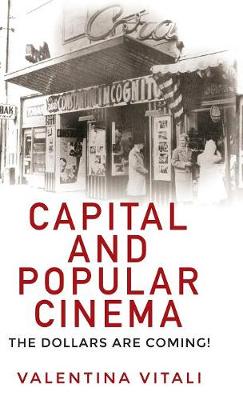
Stock image for illustration purposes only - book cover, edition or condition may vary.
Capital and Popular Cinema: The Dollars Are Coming!
Valentina Vitali
€ 143.44
FREE Delivery in Ireland
Description for Capital and Popular Cinema: The Dollars Are Coming!
Hardcover. Num Pages: 232 pages, Illustrations, black & white. BIC Classification: APFA. Category: (G) General (US: Trade). Dimension: 225 x 145 x 23. Weight in Grams: 404.
Popular cinema has mostly been discussed from a 'cult' perspective that celebrates uncritically its 'transgressive' qualities. Capital and popular cinema responds to the need for a more solid academic approach by situating 'low' film genres in their economic and culturally-specific contexts and by exploring the interconnections between those contexts, the immediate industrial-financial interests sustaining the films, and the films' aesthetics. Through the examination of three different cycles in film production - the Italian giallo of Mario Bava, the Mexican films of Fernando Mendez, and the Hindi horror cinema of the Ramsay Brothers - Capital and popular cinema proposes a comparative approach that accounts for the whole of a national film industry's production ('popular' and 'canonic'), and is applicable to the study of film genres globally. Based on new research, Capital and popular cinema will be of interest to undergraduate and post-graduate students, researchers and scholars of cult and exploitation cinema, genre cinema, national cinema, film and media theory, and area studies. -- .
Product Details
Publisher
Manchester University Press
Format
Hardback
Publication date
2016
Condition
New
Weight
403g
Number of Pages
232
Place of Publication
Manchester, United Kingdom
ISBN
9780719099656
SKU
V9780719099656
Shipping Time
Usually ships in 15 to 20 working days
Ref
99-15
About Valentina Vitali
Valentina Vitali is Reader in Film Studies at the University of East London -- .
Reviews for Capital and Popular Cinema: The Dollars Are Coming!
'Capital and Popular Cinema . makes a convincing case for a more politically engaged form of film studies: For the study of films cannot be reduced to the chronicling of films and cinema. It emerged as a radical, intellectual endeavour to figure out how, precisely, industrial cultural artefacts condition our everyday lives, and, with that aesthetic understanding, to arrive at a clearer sense of where we may want to be heading. (p. 167) The comparative model at the heart of the book also responds to the acknowledged need to reshape national film historiography in order to interrogate the impact of transnational flows and exchanges. Given the importance of the distinct national contexts of Italy, Mexico and India within Vitali's model, however, this is not an approach to the transnational that downplays the importance of the nation state but rather positions the national within a comparative framework. Indeed, the book concludes with a discussion of possible future case studies on Spain, Germany, Turkey and Nigeria so it is clear that this is a project that takes seriously Paul Willemen's call for a truly comparative film studies, and has considerable potential for further development beyond this initial monograph.' The Year's Work in Critical and Cultural Theory
.
.
